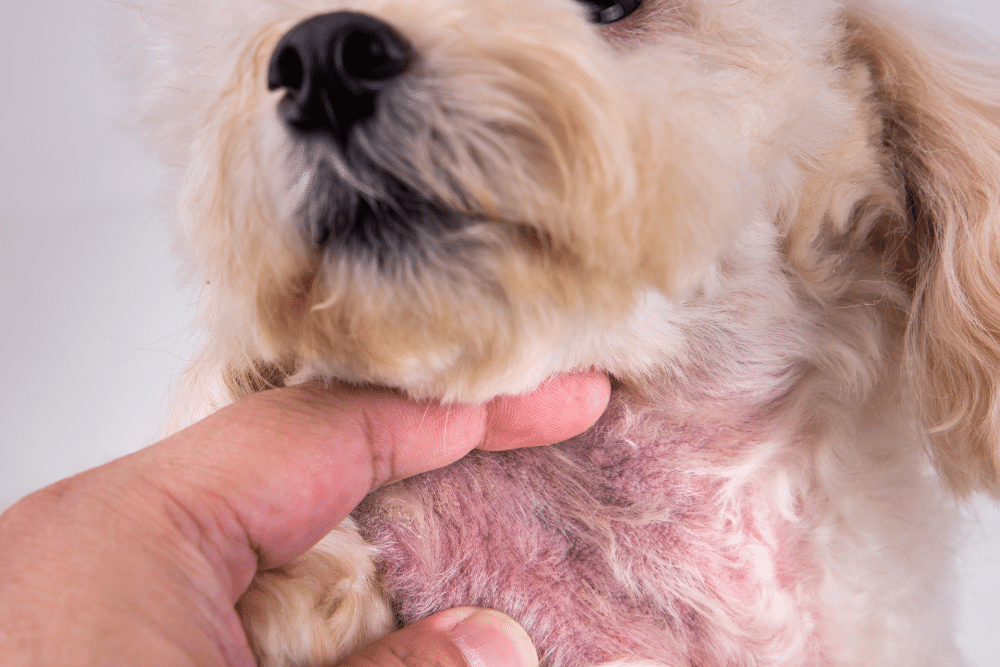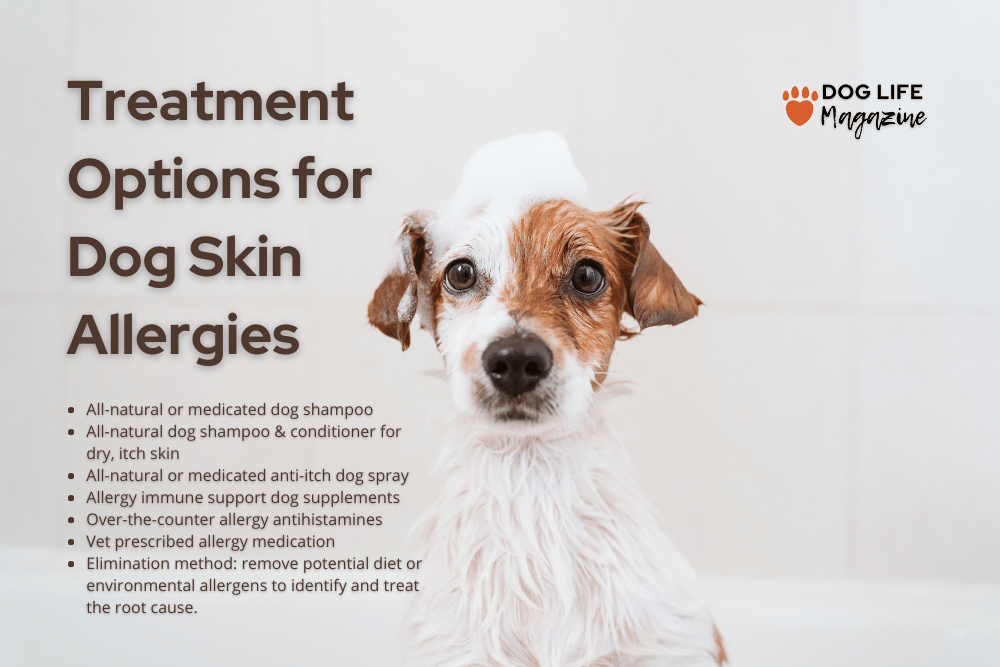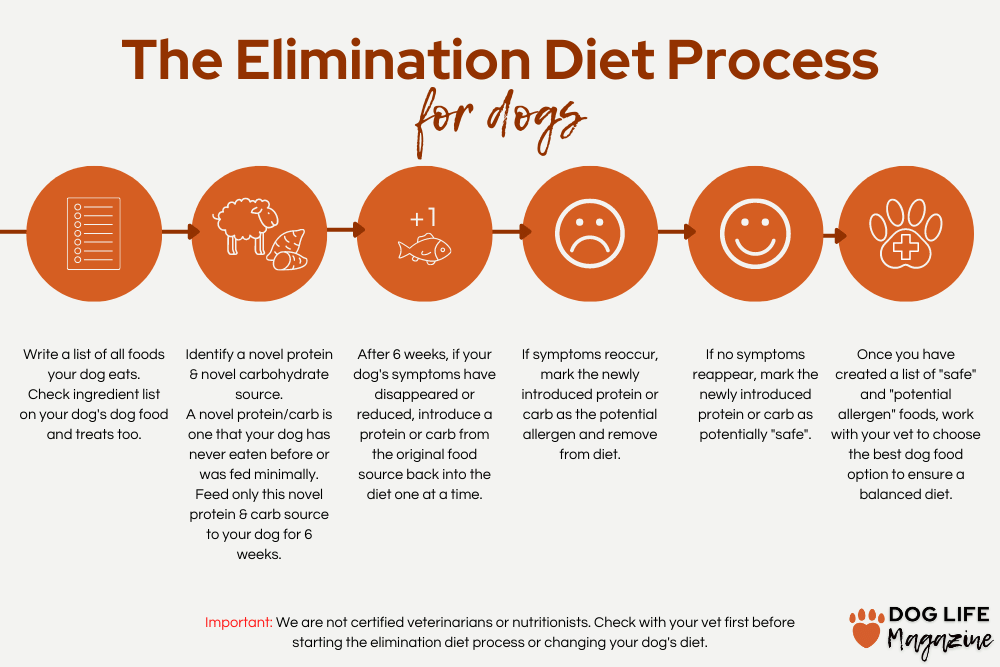So you’re itching to know a little more about dog skin allergies, yes?
OK, a little flat. But rarely does a dog get through its life span without some ear-scratching, paw-licking, pink bumps, or bald spots.
The topic of allergies is actually complex, considering how casually the terms “allergies” and “allergic” are used to explain a host of symptoms and mysterious issues.
And that holds true for skin allergies in dogs, too.
So let’s do some surface-scratchin’ and uncover the basics of skin and allergies.
Dog Allergy Symptoms & Signs
First, just as in humans, the skin is a dog’s largest organ. A lot goes on there. And a lot shows up there, too.
When it comes to allergic reactions, a dog’s skin is often more of a “messenger” than the actual site of a causative issue or underlying allergy.
In that regard, it’s always wise to pay attention to what shows up on your dog’s skin and how your dog is reacting to what may or may not be visible.

Is he scratching, licking, chewing? Is there swelling on his face or body? Does he have patches of fur falling out?
Are his eyes running? Is he having difficulty breathing? Are his gums gray or his tongue blue?
Is he having gastrointestinal issues like diarrhea or vomiting?
Allergies, simply put, are an immune response to a foreign substance that is usually harmless.
The allergic reaction you see (and your dog feels) happens when antibodies produced by the immune system attack the perceived intruder, or antigen/allergen.
The production and presence of antibodies are essential for an allergy to exist. No antibody? No allergy and no reaction.
Antibodies are specific to the antigens (or allergens) they fight. Think of them as man-to-man coverage in football or basketball.
If a certain allergen to which the body has previously been sensitized presents in or on the body, the antibody, ready and waiting, attacks it. And that’s the symptomatic reaction your dog experiences and you usually witness as a dog skin allergy.
Signs of Dog Allergy
Your dog’s allergic reactions, whether on the skin or not, will be one of three types:
- Urticaria: itchy or non-itchy hives, bumps, or rash
- Angioedema: moderate to severe swelling in the deep layers of the skin, usually on the face (as in response to an insect bite or sting)
- Anaphylaxis: severe reaction that usually presents as itching, hives, swelling, drooling, vomiting, and diarrhea, and that may become systemic and potentially fatal
Causes of dog skin allergies

Dog skin allergies, called allergic dermatitis, have three main causes:
1. Flea allergy dermatitis
This is an allergic reaction to fleabites. A dog that is allergic to flea saliva will become extremely itchy, especially at the base of the tail. The skin may also be red, inflamed, and scabbed. And you may even see “flea dirt” or the fleas themselves.
Fleas are treated both externally and internally.
If your dog shows signs of fleas, bathing with soap and water, then combing with a flea comb, will kill adult fleas. This will not, however, be enough to solve the underlying problem.
It will treat part of the problem (temporarily) and symptoms of the skin allergy. But it won’t keep fleas from coming back or laying more eggs.
You will need to talk with your vet to make sure your dog has the best preventative for fleas and other parasites. Several heartworm preventatives, like Trifexis, have flea prevention built in.
If your dog has ever been bitten by other insects such as spiders, bees, or wasps, you may have witnessed the antibody: allergen warfare in the form of alarming puffiness and redness at the bite site.
Always better safe than sorry, of course, so a trip to the vet is good practice. Usually a strong dose of an antihistamine like Benadryl will bring down the swelling and quiet the allergic reaction.
2. Food allergies
You hear about them all the time. You may even buy hypoallergenic foods for your dog.
But true food allergies that elicit an immune response are rare compared to food sensitivities that can cause reactions like itchy paws and ears.
Food allergies can, of course, cause the same reactions, but are often accompanied by gastrointestinal symptoms.
In extreme cases, a true food allergy can even be fatal, similar to the way peanut allergies cause life-threatening anaphylaxis in some people.
3. Environmental allergens
These may be seasonal, just as they are for humans. Mold and pollen, for example, can affect Fido just as they can people.
When it comes to specific environmental substances that cause skin allergies in dogs, many come from plants. They could be right in your garden or lurking along the trails on your hikes.
Think of how contact with poison ivy affects our skin. The rash, the blisters, the maddening itching. It’s the same for your pup when he comes into contact with specific substances in his environment.
Before planting your spring garden, check your intended plants against this list of plants that are toxic and non-toxic to dogs and cats.
Treatment for dog skin allergies

Dog skin allergies can be treated for their symptoms with medications, including over-the-counter antihistamines like Benadryl and Zyrtec.
Depending on the specific kind of allergic reaction (e.g. contact dermatitis vs. food allergy), using a medicated shampoo, oatmeal shampoo, anti-itch sprays and/or allergy supplements can help ease itchiness and rashes.
Below are some dog skin allergy products our team has tested and approved:
- Allergy Itch Relief Dog Shampoo for Seasonal Allergies
- Hot Spot & Itch Relief Medicated Shampoo for Dogs
- All Natural 2-in-1 Shampoo & Conditioner for Itchy Dry Skin
- Hot Spot & Itch Relief Medicated Spray for Dogs
- All Natural Anti-Itch Spray for Dogs
- Allergy Immune Supplement for Dogs – Anti Itch & Skin Hot Spots
In our opinion:
Treating symptoms isn’t the same as treating the cause of the problem.
The word “allergy” may not sound very ominous. But dog allergies, just like human allergies, can signal a need to avoid specific triggers altogether.
Whether your buddy is hyper-sensitive to everything that touches him or has inherited proclivities that could be serious, it’s worth working with your vet to get to the root cause.
In our experience:
The team here at Dog Life Mag has experienced its share of skin allergies with their dogs. We’ve learned that in certain cases its been useful to get a second opinion. Also, using the elimination method to identify the root cause and treat your pet for the cause versus medicate, and put a band aid on the cause, has been a go-to for us.
For instance, one pup here at Dog Life Mag started off with symptoms of vomiting bile, then vomiting up her whole meal, then eventually it led to her rectally hemorrhaging blood. She was in the pet ER and the vets were unsure of the cause and weren’t giving her a promising prognosis (they said she wasn’t going to make it).
Her parents frantically began to research. They found that, in some scenarios similar to their dog’s, the cause was food allergy related (an allergy to chicken and rice).
If you’ve ever had a dog with upset stomach, you’d know that vet’s typically suggest to feed them a bland diet of chicken and rice. Chicken and rice was not only in the kibble diet of our dog in the ER, but it also just so happened to be what the vets were feeding her in the ER!
After consulting with the vet, they switched her diet to fresh bison, sweet potato, carrot and green beans and she immediately began to heal and recover. She has been one of the healthiest dogs on staff ever since.

Why we chose what we chose:
You may not be the one scratching behind your ears. But we know you love the one who is. And we do too. That is why we typically do not choose medication right away, unless of course it will put your pet’s life and health at risk, always err on the side of caution and listen to your vet in those circumstances.
We usually address a dog health issue, such as a dog skin allergy, by first eliminating all or as many potential allergens as possible, be it food or environmental. Then we slowly add them back in, one by one, to see if we can identify the root cause.
Whether its fleas, the season, food or a toxic plant, your dog’s skin allergy symptoms such as hot spots, itchy dermatitis, swelling, gastrointestinal upset, and especially anaphylaxis cannot be overlooked.
Work with your vet, but also spend some time doing some digging (research) yourself. Together, your furry friend, you and your vet need to find the root cause and best treatment plan so your dog is doing less itching and more playing.








